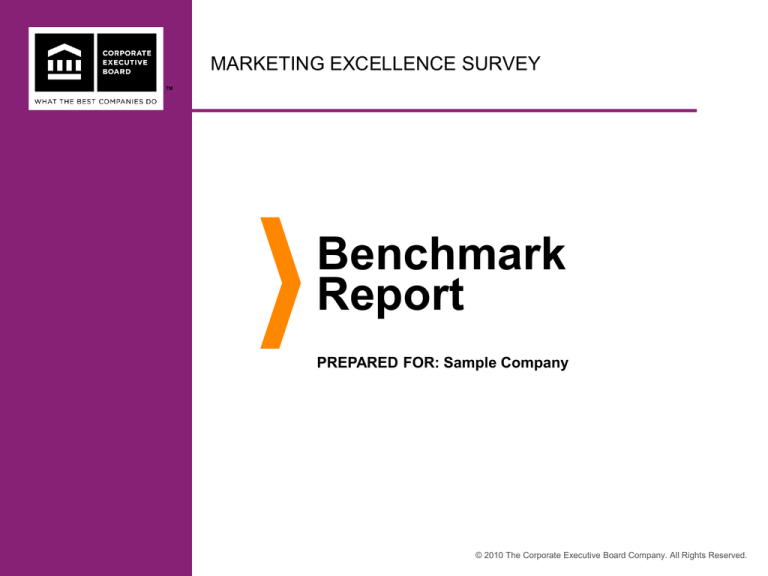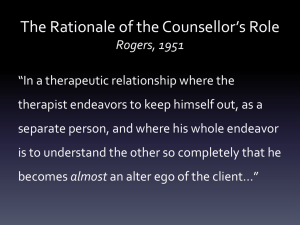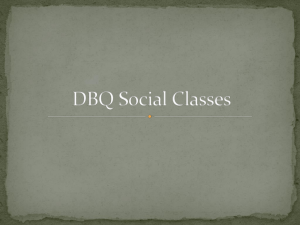
MARKETING EXCELLENCE SURVEY
™
Benchmark
Report
PREPARED FOR: Sample Company
© 2010 The Corporate Executive Board Company. All Rights Reserved.
Table of Contents
Survey Overview……………………………………………………………………………………………………...
3
Section I: Marketing Knowledge and Attitude Performance………………………………………………….
4
Section II: Marketing Application and Planning ……………………………………………………………….
18
Section III: Marketing Talent Management………………………………………………………………………
25
Appendix: Analysis Tools …………………………………………………………………………………………
32
The Marketing Excellence Survey (MES) is a product marketed by the Corporate Executive Board. Permission to use this report and its results is
granted solely to Sample Company.
2
SURVEY OVERVIEW
Marketing Excellence Survey Overview
What We Know
Marketing
Knowledge
What We Believe
Marketing
Attitudes
Scale:
0 – 160
Don’t Know: 80
Benchmark: 100
How We Think
How We Act
Marketing
Strategies
Marketing
Decisions
Scale:
0 – 100
Cause for
Concern:
60
Benchmark: 80
MES Benchmark Database
WORLDWIDE REPRESENTATION
Geographic Area
Countries
Percent
Africa
16
2%
Asia-Pacific
29
11%
Europe
41
19%
Latin America
13
4%
North America
11
54%
Oceania
2
5%
Worldwide
n/a
5%
JOB FUNCTION REPRESENTATION
Marketing Management . . . . . . . . . . . .
Product Management . . . . . . . . . . . . . .
Marketing Professional/Support . . . . . .
Sales/Sales Management . . . . . . . . . .
General/Senior Management . . . . . . . .
Planning/Bus/Mkt Development . . . . . .
Marketing Communications . . . . . . . . .
Business Support . . . . . . . . . . . . . . . . .
Engineering/R&D/Technology . . . . . . .
Customer Service/Tech Support . . . . .
Manufacturing/Supply Chain. . . . . . . . .
Other . . . . . . . . . . . . . . . . . . . . . . . . . . .
21%
14%
12%
12%
8%
6%
6%
5%
4%
3%
2%
7%
INDUSTRY SECTOR REPRESENTATION
Industry Sector
Percent
Business Products
13%
Consumer
4%
High Technology
20%
Industrial
45%
Medical/Health
7%
Service
11%
3
™
SECTION I
MARKETING KNOWLEDGE
AND ATTITUDES PERFORMANCE
© 2010 The Corporate Executive Board Company. All Rights Reserved.
SECTION I: MARKETING KNOWLEDGE AND ATTITUDES PERFORMANCE
Marketing Knowledge Performance
MES Database Snapshot
Marketing Knowledge Overall Scores
Your Industry Average
89
Top 20%
108
Average
90
Bottom 20%
75
Description: These charts show your company’s overall and core marketing knowledge scores. Scores below an 80
indicate a lack of knowledge in a core area while scores above 100 indicate a strength. Marketing Knowledge
contributes to business performance. Low scores indicate an opportunity to increase your ability to impact your
business.
5
SECTION I: MARKETING KNOWLEDGE AND ATTITUDES PERFORMANCE
Marketing Knowledge Score Distribution
Average Score: 85
Range: 65 to 115
Description: This chart shows the distribution of Marketing Knowledge scores across your organization. You can
determine the size of the training need in your organization through the total % of the population situated in the left two
bars on the chart.
6
SECTION I: MARKETING KNOWLEDGE AND ATTITUDES PERFORMANCE
Marketing Knowledge Score by Job Function
* To ensure confidentiality, any value representing fewer than three respondents is not reported.
Description: This chart shows your company’s Marketing Knowledge scores across job functions. Gaps greater than
five points could point to difficulties in executing marketing activities. Determine which job functions require development
and which ones can be leveraged to further build your organization’s marketing capability.
7
SECTION I: MARKETING KNOWLEDGE AND ATTITUDES PERFORMANCE
Marketing Knowledge Score by Business Unit
* To ensure confidentiality, any value representing fewer than three respondents is not reported.
Description: This chart shows your company’s Marketing Knowledge scores across your company’s demographics.
Gaps greater than five points could point to difficulties in executing marketing activities. Determine which areas require
development and which ones can be leveraged to further build your organization’s marketing capability.
8
SECTION I: MARKETING KNOWLEDGE AND ATTITUDES PERFORMANCE
Marketing Attitudes Performance
MES Database Snapshot
Marketing Attitudes Overall Scores
Your Industry Average
67
Top 20%
85
Average
69
Bottom 20%
52
Description: These charts show your company’s overall and core marketing attitudes scores. Scores below a 60
indicate a very internally focused attitude in a core area while scores above 80 indicate a very externally, or marketoriented attitude. Marketing attitudes help shape the actual activities of a marketing organization and may reflect internal
cultural values.
9
SECTION I: MARKETING KNOWLEDGE AND ATTITUDES PERFORMANCE
Marketing Attitudes Score Distribution
Average Score: 65
Range: 39 to 94
Description: This chart shows the distribution of Marketing Attitudes scores across your organization. You can
determine the size of the training need in your organization through the total % of the population situated in the left two
bars on the chart.
10
SECTION I: MARKETING KNOWLEDGE AND ATTITUDES PERFORMANCE
Marketing Attitudes Score by Job Function
* To ensure confidentiality, any value representing fewer than three respondents is not reported.
Description: This chart shows your company’s Marketing Attitudes scores across job functions. Gaps greater than five
points could point to difficulties in executing marketing activities. Determine which job functions require development and
which ones can be leveraged to further build your organization’s marketing capability.
11
SECTION I: MARKETING KNOWLEDGE AND ATTITUDES PERFORMANCE
Marketing Attitudes Score by Business Unit
* To ensure confidentiality, any value representing fewer than three respondents is not reported.
Description: This chart shows your company’s Marketing Attitudes scores across your company’s demographics. Gaps
greater than five points could point to difficulties in executing marketing activities. Determine which areas require
development and which ones can be leveraged to further build your organization’s marketing capability.
12
SECTION I: MARKETING KNOWLEDGE AND ATTITUDES PERFORMANCE
Job Function Mapping
Sample Company
Marketing Excellence Survey
Segment Marketing Manager (31)
General/Senior Management (31)
Marketing Leadership / Senior Management (24)
Marketing Management (24)
Data Analyst (2)
Editor (36)
Marketing Professional/Support (38)
Product Management (0)
Communications Project Leader (33)
Marketing Communications (33)
Event Planner (6)
Graphic Designer (6)
Research Coordinator (13)
Planning/Business/Marketing Development (25)
Sales/Sales Management (0)
Customer Service/Tech Support (0)
Inventory Specialist (18)
Engineering/R&D/Technology (18)
Manufacturing/Supply Chain (0)
Administrative Assistant (10)
Business Support (10)
Proof Reader (16)
Other (16)
Description: This table shows how your company’s roles were mapped to the MES Database Job Functions for
benchmarking purposes. The numbers in parenthesis indicate the number of people assigned to each category.
13
SECTION I: MARKETING KNOWLEDGE AND ATTITUDES PERFORMANCE
Marketing Knowledge Score
Benchmarked by Industry by Job Function
Marketing Excellence Survey Database
Marketing Knowledge by MES DB
Job Function
Company
Average
Business
Products
Consumer
General/Senior Management
85
110
116
Marketing Management
94
106
116
Product Management
90
Marketing Professional/Support
85
Marketing Communications
82
*
Planning/Business/Marketing Dev.
80
93
Sales/Sales Management
96
*
Industrial
Medical/
Health
Service
115
110
131
101
114
104
100
96
110
102
98
105
98
100
105
89
*
109
110
High Tech
*
94
105
103
Customer Service/Tech Support
Engineering/R&D/Technology
88
*
82
102
Manufacturing/Supply Chain
Business Support
85
Other
84
Average
Average – Top 3 Businesses by Industry
Overall Industry Average Scores
85
95
*
95
110
101
98
96
107
98
98
89
90
91
90
108
79
100
99
111
96
98
105
90
92
*
* To ensure confidentiality, any value representing fewer than three respondents is not reported.
Description: This table shows the Marketing Knowledge scores by MES job function benchmarked across the top
performing businesses in each industry from the MES database. Determine which areas have the largest gaps to set
job-specific and company targets for improvement.
14
SECTION I: MARKETING KNOWLEDGE AND ATTITUDES PERFORMANCE
Marketing Attitudes Score
Benchmarked by Industry by Job Function
Marketing Excellence Survey Database
Marketing Attitudes by MES DB
Job Function
Company
Average
Business
Products
Consumer
General/Senior Management
67
81
80
Marketing Management
73
79
81
Product Management
78
Marketing Professional/Support
67
74
Marketing Communications
62
*
Planning/Business/Marketing Dev.
60
78
Sales/Sales Management
*
Industrial
Medical/
Health
Service
80
78
87
83
79
80
80
77
78
82
79
77
76
81
80
71
*
78
83
High Tech
*
74
83
74
Customer Service/Tech Support
Engineering/R&D/Technology
80
*
62
79
Manufacturing/Supply Chain
Business Support
65
Other
67
Average
Average – Top 3 Businesses by Industry
Overall Industry Average Scores
65
75
*
75
78
79
79
76
78
74
75
70
70
69
70
78
61
78
77
79
77
77
77
71
70
*
* To ensure confidentiality, any value representing fewer than three respondents is not reported.
Description: These charts show your company’s overall and core Marketing Attitudes scores. Scores below a 60
indicate a very internally focused attitude in a core area while scores above 80 indicate a very externally, or marketoriented attitude. Marketing Attitudes help shape the actual activities of a marketing organization and may reflect internal
cultural values.
15
SECTION I: MARKETING KNOWLEDGE AND ATTITUDES PERFORMANCE
Marketing Knowledge Vs. Self-Rated Familiarity
Communicate Skills
Desired Position
Individuals know more about marketing
concepts and tools than they say they do.
Individuals say they are familiar with
marketing concepts and tools and they
actually score high in knowledge of them.
Recognized Need
Danger Zone
Individuals don’t know about marketing
concepts and tools, and they admit they
don’t know about them.
Individuals say they are familiar with
marketing concepts and tools but score
low in knowledge of them.
Description: This chart shows the contrast between the organization’s actual knowledge and their self-rated familiarity
across the core Marketing Knowledge areas. The goal is shift people from the bottom two quadrants into the ‘Desired
Position’ through awareness and education.
16
SECTION I: MARKETING KNOWLEDGE AND ATTITUDES PERFORMANCE
Individual Barriers to Increasing Marketing Excellence
Description: This chart shows what employees consider as their biggest personal barriers to achieving marketing
excellence. As your organization works to improve marketing knowledge, they should also address other individual
barriers to create success.
17
™
SECTION II
MARKETING APPLICATION AND
PLANNING
© 2010 The Corporate Executive Board Company. All Rights Reserved.
SECTION II: MARKETING APPLICATION AND PLANNING
Marketing Knowledge Score Vs. Application of Marketing
Concepts
Training Needed
Knowledge areas falling in this quadrant
indicate a low level of Marketing
Knowledge paired with a high level of
Application of the associated concepts.
As this is a highly used concept,
development in this area should be a
priority and should be broadly
administered to staff.
Targeted Development
Knowledge areas falling in this quadrant
indicate a low level of Marketing
Knowledge paired with a low level of
Application of the associated concepts.
Development should be targeted toward
raising knowledge levels of staff who use
the corresponding concepts.
Coaching Bench
Knowledge areas falling in this quadrant
indicate a high level of Marketing
Knowledge paired with a high level of
Application of the associated concepts.
As this is a highly used concept within the
organization, groups with strength in this
area should be leveraged to coach
groups with lower knowledge levels in this
area.
Underutilized Resource
Knowledge areas falling in this quadrant
indicate a high level of Marketing
Knowledge paired with a low level of
Application of the associated concepts.
This is an underutilized concept in the
organization. Development should be
targeted at raising knowledge and use of
concepts in this area broadly across all
groups.
Description: This chart shows the relationship between marketing knowledge and the application of marketing concepts
on the job. Determine if those with the right marketing knowledge are applying marketing concepts on the job. Take
appropriate actions where either the required knowledge or application is missing.
19
SECTION II: MARKETING APPLICATION AND PLANNING
Marketing Application Areas
Description: This chart shows how marketing concepts are applied throughout your organization. Ensure that
marketing is being applied in the job functions with the greatest responsibility for executing marketing activities.
20
SECTION II: MARKETING APPLICATION AND PLANNING
Job Level Vs. Marketing Plan Quality
Overconfident
Over confidence in quality of marketing
plan without requisite marketing
knowledge to accurately judge plan
quality.
Desired Position
High level of confidence in the marketing
plan and higher knowledge levels indicate
ability to consistently produce high quality
plans.
Danger Zone
Execution Challenge
Low level of confidence in the marketing
plan quality and lower levels of marketing
knowledge indicate need for upskilling on
marketing planning – skills and
application.
Higher knowledge scores indicate ability
to accurately judge quality of marketing
plans. Development opportunity in how to
apply marketing knowledge to create
better plans.
Description: This chart shows the relationship between job level and the quality of marketing plans. Determine if job
level is contributing to higher quality plans. Use this information as an input to improving marketing planning in your
organization.
21
SECTION II: MARKETING APPLICATION AND PLANNING
Marketing Plan Quality Across the Organization
Description: This chart shows the perceived quality of marketing plans throughout the organization. Determine which
areas have the highest quality ratings and if marketing planning is executed across job levels.
22
SECTION II: MARKETING APPLICATION AND PLANNING
Preparation to Lead Marketing Excellence
Description: This chart shows the % of your organization across each job level that is very prepared to lead marketing
excellence in your organization and their corresponding marketing knowledge score. Ensure that those roles who rate
themselves as being prepared have the requisite knowledge to lead change.
23
SECTION II: MARKETING APPLICATION AND PLANNING
Organizational Barriers to Increasing Marketing Excellence
Description: This chart shows what employees consider as their biggest organizational barriers to achieving marketing
excellence. As your organization works to improve marketing knowledge, they should also address other organizational
barriers to create success.
24
™
SECTION III
MARKETING TALENT MANAGEMENT
© 2010 The Corporate Executive Board Company. All Rights Reserved.
SECTION III: MARKETING TALENT MANAGEMENT
Marketing Knowledge/Attitudes Score by Formal Education
Description: These charts show your organization’s marketing knowledge and attitudes scores across the amount of
formal education. High scoring areas can be used as an input into your organization’s recruitment strategies.
26
SECTION III: MARKETING TALENT MANAGEMENT
Marketing Knowledge/Attitudes Score by Marketing Experience
Description: These charts show your organization’s marketing knowledge and attitudes scores across the amount of
self-rated experience in marketing. Determine if there is a positive relationship between experience and knowledge and
how many people within your organization consider themselves experienced.
27
SECTION III: MARKETING TALENT MANAGEMENT
Sources of Marketing Talent
External Hire Profile:
•Education:
None
•Degree:
Bachelors (4 year college or university degree)
•Geography:
North America
•Experience:
Some (<2 Yrs)
Internal Hire Profile:
•Education:
None
•Degree:
Bachelors (4 year college or university degree)
•Geography:
North America
•Experience:
Some (<2 Yrs)
Description: These charts show the marketing knowledge scores for those individuals arriving in the marketing function
as an external hire or through an internal transfer along with the % arriving from each source. Use this as an input into
your recruitment strategies.
28
SECTION III: MARKETING TALENT MANAGEMENT
Marketing Training History
Description: This chart shows the distribution of marketing training received by your organization over time. Compare
your organization’s training history to the top 20% of companies as well as the MES database average to set appropriate
training goals.
29
SECTION III: MARKETING TALENT MANAGEMENT
Marketing Knowledge/Attitudes Score by Tenure
Description: These charts show your organization’s marketing knowledge and attitude scores across tenure categories.
Determine if marketing knowledge and attitudes improve over time and if there are pockets within the organization that
require development.
30
SECTION III: MARKETING TALENT MANAGEMENT
Marketing Talent Pipeline
Description: These chart shows the marketing knowledge scores across the job levels in your organization. Determine
if there are any gaps greater that five points between job levels. You should strive to minimize the size of the knowledge
gaps between the job levels to ensure a strong marketing talent pipeline.
31
™
APPENDIX
KNOWLEDGE AND ATTITUDES
ANALYSIS TOOLS
© 2010 The Corporate Executive Board Company. All Rights Reserved.
APPENDIX
Marketing Knowledge Analysis Tools
• Marketing Knowledge Benchmarks by Region – Your organization’s marketing
knowledge scores by job function are benchmarked across region
• Marketing Knowledge Demographic Crosstabs – Your organization’s marketing
knowledge scores are presented by demographic across each of the core knowledge
areas
• Marketing Knowledge Variance Analysis – Your organization’s marketing knowledge
scores are divided into fifths based on overall marketing knowledge. The average
scores for the “top fifth” and “bottom fifth” indicate the range of marketing knowledge in
each core area.
• Marketing Knowledge Performance Scorecards – Your organization’s marketing
knowledge scores are displayed on a scorecard for each core area of marketing
knowledge showing the Performance Gap and an Action Index for each Job Function.
• Marketing Knowledge Score Gaps – Your organization’s marketing knowledge scores
are described in detail to help you understand the core area performance gaps.
33
APPENDIX
Marketing Knowledge Core Areas
The MES Marketing Knowledge Scale is built around knowledge statements that cover these four core areas
of marketing knowledge.
Marketing Knowledge
Strategic
Marketing
Marketing
Profitability
Market
Analysis
Industry/Market
Attractiveness
Customer &
Competitor Analysis
Pricing & Product
Life Cycle Profits
Competitive
Strategy
Market
Segmentation
Margin
Management
Marketing
Planning
Market
Research
Marketing
Metrics
Sample Question:
Marketing Mix
Strategy
Marketing
Mix
Positioning
Strategies
Promotion &
Place Strategies
Customer satisfaction is a key driver of profitability.
______
______
Definitely
False
Probably
False
______
______
_______
Don’t
Know
Probably
True
Definitely
True
34
APPENDIX
Marketing Knowledge Score
Benchmarked by Region
Marketing Excellence Survey Database
Marketing Knowledge by MES
DB Job Function
Company
Average
Africa
Asia-Pacific
Europe
Latin
America
North
America
Oceania
Worldwide
General/Senior Management
85
91
91
95
93
95
94
100
Marketing Management
94
90
89
93
92
93
96
96
Product Management
85
88
92
92
92
91
94
Marketing Professional/Support
85
84
88
90
91
89
91
91
Marketing Communications
82
84
86
88
88
87
89
88
Planning/Business/Marketing Dev.
80
87
88
95
92
94
90
95
Sales/Sales Management
83
85
88
86
85
87
90
Customer Service/Tech Support
82
86
85
82
83
84
83
80
85
87
82
86
87
90
81
89
85
83
86
85
90
84
90
90
89
88
85
90
87
89
88
88
94
90
88
90
88
89
89
91
Engineering/R&D/Technology
82
Manufacturing/Supply Chain
Business Support
85
Other
84
Average
85
85
Description: This table shows the marketing knowledge scores by MES job function benchmarked across the regions
contained within the MES database.
35
APPENDIX
Marketing Knowledge Score Across Core Areas
Don't Know
Below Average
Average
Above Benchmark
Top Performer
Core Areas of Marketing Knowledge
Market
Marketing Mix
Marketing
Analysis
Strategies
Profitability
Average
Range
Strategic
Marketing
Marketing Leadership / Senior Management (24)
94
75-115
107
96
100
75
Segment Marketing Manager (31)
85
65-105
94
87
88
71
Communications Project Leader (33)
82
71-99
85
81
85
77
Editor (36)
85
74-109
93
85
85
79
Proof Reader (16)
84
78-92
89
83
86
77
Graphic Designer (6)
79
76-82
81
72
81
82
Inventory Specialist (18)
82
70-92
86
85
80
76
Research Coordinator (13)
79
70-84
77
84
75
80
*
*
*
*
*
*
Event Planner (6)
82
74-95
84
79
87
79
Administrative Assistant (10)
85
75-101
87
90
78
86
Average
85
65-115
90
85
86
77
Job Function
Data Analyst (2)
* To ensure confidentiality, any value representing fewer than three respondents is not reported.
Description: This table shows the marketing knowledge scores for each core area across your company’s
demographics.
36
APPENDIX
Marketing Knowledge Score Across Core Areas
Don't Know
Below Average
Average
Above Benchmark
Top Performer
Core Areas of Marketing Knowledge
Business Unit
Strategic
Marketing
Market
Analysis
Marketing Mix
Strategies
Marketing
Profitability
Average
Range
Business Unit A (53)
84
71-109
91
82
86
76
Business Unit B (64)
84
65-115
90
85
86
77
Business Unit C (73)
85
70-105
90
88
86
77
Business Unit D (3)
91
84-101
108
100
78
77
Business Unit E (2)
*
*
*
*
*
*
85
65-115
90
85
86
77
Average
* To ensure confidentiality, any value representing fewer than three respondents is not reported.
Description: This table shows the marketing knowledge scores for each core area across your company’s
demographics.
37
APPENDIX
Marketing Knowledge Score Variance Analysis
Description: This graph shows the variance in marketing knowledge for each core area based on the overall marketing
knowledge score. The bars labelled “top fifth” are the top fifth in overall marketing knowledge. They are the same people
in each core area labelled top fifth. The same is true for the bottom fifth.. The middle bars show the overall average
marketing knowledge scores for each core area.
38
APPENDIX
Marketing Knowledge Score Distribution
Strategic Marketing
Percentage Distribution
Company
Average
Don't Know
Below
Average
Below
Average
Average
Above
Benchmark
Above
Benchmark
General/Senior Management (31)
94
35%
10%
13%
26%
16%
Marketing Management (24)
107
12%
4%
17%
17%
50%
Marketing Professional/Support (36)
93
28%
17%
19%
17%
19%
Marketing Communications (33)
85
52%
15%
12%
15%
6%
Planning/Business/Marketing Dev. (6)
81
50%
33%
0%
17%
0%
86
61%
6%
22%
6%
6%
Business Support (10)
87
40%
20%
20%
10%
10%
Other (16)
89
31%
25%
31%
0%
12%
Don't Know
Strategic Marketing by
Job Function
Average
Top
Performer
Top
Performer
Product Management ()
Sales/Sales Management ()
Customer Service/Tech Support ()
Engineering/R&D/Technology (18)
Manufacturing/Supply Chain ()
* To ensure confidentiality, any value representing fewer than three respondents is not reported.
Description: This table shows the distribution of marketing knowledge scores across Strategic Marketing for each job
function.
39
APPENDIX
Marketing Knowledge Score Distribution
Market Analysis
Percentage Distribution
Company
Average
Don't Know
Below
Average
Below
Average
Average
Above
Benchmark
Above
Benchmark
General/Senior Management (31)
87
32%
26%
26%
10%
6%
Marketing Management (24)
96
29%
8%
12%
29%
21%
Marketing Professional/Support (36)
85
44%
17%
22%
11%
6%
Marketing Communications (33)
81
64%
12%
18%
3%
3%
Planning/Business/Marketing Dev. (6)
72
83%
0%
17%
0%
0%
85
50%
17%
11%
22%
0%
Business Support (10)
90
40%
30%
10%
0%
20%
Other (16)
83
44%
25%
31%
0%
0%
Don't Know
Market Analysis by
Job Function
Average
Top
Performer
Top
Performer
Product Management ()
Sales/Sales Management ()
Customer Service/Tech Support ()
Engineering/R&D/Technology (18)
Manufacturing/Supply Chain ()
* To ensure confidentiality, any value representing fewer than three respondents is not reported.
Description: This table shows the distribution of marketing knowledge scores across Market Analysis for each job
function.
40
APPENDIX
Marketing Knowledge Score Distribution
Marketing Mix Strategies
Percentage Distribution
Company
Average
Don't Know
Below
Average
Below
Average
Average
Above
Benchmark
Above
Benchmark
General/Senior Management (31)
88
39%
19%
13%
23%
6%
Marketing Management (24)
100
17%
8%
29%
21%
25%
Marketing Professional/Support (36)
85
50%
22%
17%
8%
3%
Marketing Communications (33)
85
39%
24%
18%
15%
3%
Planning/Business/Marketing Dev. (6)
81
67%
0%
33%
0%
0%
80
61%
11%
17%
6%
6%
Business Support (10)
78
70%
10%
10%
10%
0%
Other (16)
86
44%
6%
44%
6%
0%
Don't Know
Marketing Mix Strategies by
Job Function
Average
Top
Performer
Top
Performer
Product Management ()
Sales/Sales Management ()
Customer Service/Tech Support ()
Engineering/R&D/Technology (18)
Manufacturing/Supply Chain ()
* To ensure confidentiality, any value representing fewer than three respondents is not reported.
Description: This table shows the distribution of marketing knowledge scores across Marketing Mix Strategies for
each job function.
41
APPENDIX
Marketing Knowledge Score Distribution
Marketing Profitability
Percentage Distribution
Marketing Profitability by
Job Function
Company
Average
Don't Know
Below
Average
Below
Average
Average
Above
Benchmark
Above
Benchmark
General/Senior Management (31)
71
71%
13%
10%
6%
0%
Marketing Management (24)
75
67%
8%
17%
8%
0%
Marketing Professional/Support (36)
79
61%
14%
19%
3%
3%
Marketing Communications (33)
77
58%
30%
9%
3%
0%
Planning/Business/Marketing Dev. (6)
82
67%
0%
33%
0%
0%
76
78%
6%
6%
6%
6%
Business Support (10)
86
50%
10%
20%
10%
10%
Other (16)
77
75%
0%
25%
0%
0%
Don't Know
Average
Top
Performer
Top
Performer
Product Management ()
Sales/Sales Management ()
Customer Service/Tech Support ()
Engineering/R&D/Technology (18)
Manufacturing/Supply Chain ()
* To ensure confidentiality, any value representing fewer than three respondents is not reported.
Description: This table shows the distribution of marketing knowledge scores across Marketing Profitability for each
job function.
42
APPENDIX
Marketing Knowledge Performance Scorecard
Strategic Marketing
Company
Average
MES Overall
Average
MES Top
Performers
(Top 20%)
Performance
Gap
MES Job
Relevance
Action Index
General/Senior Management (31)
94
102
130
-36
5
-180
Marketing Management (24)
107
101
129
-22
5
-110
Marketing Professional/Support (38)
92
97
126
-34
3
-102
Marketing Communications (33)
85
95
123
-38
1
-38
Planning/Business/Marketing Dev. (25)
80
102
132
-52
5
-260
86
95
122
-36
1
-36
Business Support (10)
87
96
125
-38
1
-38
Other (16)
89
96
125
-36
0
0
Strategic Marketing Job Function
Knowledge Scores
Product Management (0)
Sales/Sales Management (0)
Customer Service/Tech Support (0)
Engineering/R&D/Technology (18)
Manufacturing/Supply Chain (0)
* To ensure confidentiality, any value representing fewer than three respondents is not reported.
Note: Performance Gap = Your Job Function Average – MES Performance Benchmark
Job Relevance varies from zero (not relevant) to 5 (extremely relevant)
Action Index = Performance Gap x Job Relevance
Description: This table highlights your company’s biggest opportunities for development through the use of an Action
Index. The opportunity for development increases as the action index grows increasingly negative.
43
APPENDIX
Marketing Knowledge Performance Scorecard
Market Analysis
Company
Average
MES Overall
Average
MES Top
Performers
(Top 20%)
Performance
Gap
MES Job
Relevance
General/Senior Management (31)
87
92
119
-32
1
-32
Marketing Management (24)
96
91
118
-22
5
-110
Marketing Professional/Support (38)
84
89
116
-32
5
-160
Marketing Communications (33)
81
88
112
-31
1
-31
Planning/Business/Marketing Dev. (25)
80
92
120
-40
4
-160
85
85
110
-25
1
-25
Business Support (10)
90
86
111
-21
1
-21
Other (16)
83
89
116
-33
0
0
Market Analysis Job Function
Knowledge Scores
Action Index
Product Management (0)
Sales/Sales Management (0)
Customer Service/Tech Support (0)
Engineering/R&D/Technology (18)
Manufacturing/Supply Chain (0)
* To ensure confidentiality, any value representing fewer than three respondents is not reported.
Note: Performance Gap = Your Job Function Average – MES Performance Benchmark
Job Relevance varies from zero (not relevant) to 5 (extremely relevant)
Action Index = Performance Gap x Job Relevance
Description: This table highlights your company’s biggest opportunities for development through the use of an Action
Index. The opportunity for development increases as the action index grows increasingly negative.
44
APPENDIX
Marketing Knowledge Performance Scorecard
Marketing Mix Strategies
Company
Average
MES Overall
Average
MES Top
Performers
(Top 20%)
Performance
Gap
MES Job
Relevance
Action Index
General/Senior Management (31)
88
95
123
-35
3
-105
Marketing Management (24)
100
94
122
-22
5
-110
Marketing Professional/Support (38)
84
91
120
-36
5
-180
Marketing Communications (33)
85
90
116
-31
3
-93
Planning/Business/Marketing Dev. (25)
79
95
124
-45
3
-135
80
87
112
-32
2
-64
Business Support (10)
78
88
116
-38
3
-114
Other (16)
86
90
118
-32
0
0
Marketing Mix Strategies Job
Function Knowledge Scores
Product Management (0)
Sales/Sales Management (0)
Customer Service/Tech Support (0)
Engineering/R&D/Technology (18)
Manufacturing/Supply Chain (0)
* To ensure confidentiality, any value representing fewer than three respondents is not reported.
Note: Performance Gap = Your Job Function Average – MES Performance Benchmark
Job Relevance varies from zero (not relevant) to 5 (extremely relevant)
Action Index = Performance Gap x Job Relevance
Description: This table highlights your company’s biggest opportunities for development through the use of an Action
Index. The opportunity for development increases as the action index grows increasingly negative.
45
APPENDIX
Marketing Knowledge Performance Scorecard
Marketing Profitability
Company
Average
MES Overall
Average
MES Top
Performers
(Top 20%)
Performance
Gap
MES Job
Relevance
Action Index
General/Senior Management (31)
71
83
113
-42
5
-210
Marketing Management (24)
75
81
111
-36
5
-180
Marketing Professional/Support (38)
79
79
107
-28
5
-140
Marketing Communications (33)
77
77
102
-25
1
-25
Planning/Business/Marketing Dev. (25)
80
83
113
-33
3
-99
76
79
105
-29
1
-29
Business Support (10)
86
81
109
-23
3
-69
Other (16)
77
79
106
-29
0
0
Marketing Profitability Job Function
Knowledge Scores
Product Management (0)
Sales/Sales Management (0)
Customer Service/Tech Support (0)
Engineering/R&D/Technology (18)
Manufacturing/Supply Chain (0)
* To ensure confidentiality, any value representing fewer than three respondents is not reported.
Note: Performance Gap = Your Job Function Average – MES Performance Benchmark
Job Relevance varies from zero (not relevant) to 5 (extremely relevant)
Action Index = Performance Gap x Job Relevance
Description: This table highlights your company’s biggest opportunities for development through the use of an Action
Index. The opportunity for development increases as the action index grows increasingly negative.
46
APPENDIX
Marketing Knowledge Score Gaps – Strategic Marketing
- Knowledge Gap Average
Top Performers
6
-65
Low Cost Leadership: When to utilize a cost leadership strategy vs. a differentiation strategy in serving mass market or
niche markets.
-4
-77
Market Potential vs. Market Demand: The market potential of a market is the maximum number of units sold if all
potential customers entered the market. The gap between current market demand and market potential is the untapped
market opportunity. The larger the gap, the greater the potential for future sales growth.
-15
-76
Competitive Position: A business or product position relative to competition with respect to differentiation (product
quality, service quality, brand image, price), cost (unit cost, marketing expenses, overhead expenses), and marketing
(market share, product awareness, distribution, and sales).
-10
-47
Market Share and Profitability: The strategic importance of managing niche share positions to achieve above-average
levels of profit performance.
-3
-93
Market Attractiveness: The attractiveness of a market is based on an assessment of market forces (market size, growth
rate, buyer power, and customer loyalty), competitive intensity (number of competitors, price rivalry, ease of entry,
substitutes), and market access (customer familiarity, channel access, sales requirements, company fit). The higher a
market’s attractiveness, the better the opportunity for profitable growth.
-23
-60
Portfolio Analysis: A portfolio analysis represents the strategic position of a product or business based on market
attractiveness and competitive position. Based on a portfolio analysis, a long-run strategic market plan is specified (invest
to grow, invest to protect, reduced focus, harvest, or divest). For each type of strategic market plan, there is an expected
impact on market share, sales, and profits over a 3- to 5- year time horizon.
-1
-56
Relative Market Share: The strategic advantage of relative market share (as compared to absolute market share) and its
importance in strategic market planning and building superior levels of profitability.
-15
-47
Industry Analysis: Porter’s industry analysis is built around six forces – ease of competitor entry, ease of competitor exit,
buyer power, supplier power, substitutes, and price rivalry. When these industry forces are favorable, the opportunity for
above-average profits is greater.
Description: This shows the marketing knowledge performance gaps in the area of Strategic Marketing that were
revealed by the Marketing Excellence Survey. Knowledge gaps are derived in two ways: 1) the difference between your
company’s average and the MES Database average, and 2) the difference between your company’s average and the
average for top performers in the MES Database (top 20 percent in overall marketing knowledge).
47
APPENDIX
Marketing Knowledge Score Gaps – Market Analysis
- Knowledge Gap Average
Top Performers
7
-58
Market Segmentation: Market segmentation is built around customer needs. Market segments are groups of customers that
share a common set of needs and a certain level of price sensitivity and preference for different levels of product/service
benefits.
-10
-53
Trade-Off Analysis: This is a market research tool that allows customers to look at several combinations of product/service
features and price. Customer trade-offs between different combinations of product/service features and price allow us to
estimate customer price sensitivity and preference for different levels of product/service benefits.
-13
-61
Perceptual Mapping: A perceptual map is a two dimensional map of customer perceptions of products based on the degree to
which they are similar or dissimilar. When complete, the perceptual map provides the product positioning of all competing
products.
-11
-74
Managerial Significance: Managerial significance focuses on the meaningful differences in market research results. While the
difference between two groups of customer opinion may be statistically significant, to be managerially significant the level of
difference has to be sufficiently large to be actionable.
14
-29
Focus Groups: Focus groups consist of 7 to 12 target customers for a given product or service. The focus group leader
moderates this panel of customers in an effort to obtain their opinions on key issues like product benefits, pricing, services, and
brand names.
-1
-79
Marketing Surveys: Marketing surveys include mail surveys, telephone surveys, Internet surveys, customer usage surveys,
and day-in-the-life surveys. Mail, telephone, and Internet surveys are best used for tracking customers’ perceptions for your
product and competitors. Usage surveys and day-in-the-life surveys are better at uncovering unmet needs and problems
customers encounter in acquiring, installing, using, maintaining, and disposing of a product.
-16
-49
Cluster Analysis: Cluster analysis is a market research tool that is used in market segmentation. Cluster analysis allows us to
group customers into segments based on similar preferences for product and service features and price levels.
-1
-74
Mass Customization: Mass customization enables customers to bundle their own product based on their preferred
combination of product features, preferred services, and price. Mass customization allows each customer to be a unique
segment.
Description: This shows the marketing knowledge performance gaps in the area of Market Analysis that were
revealed by the Marketing Excellence Survey. Knowledge gaps are derived in two ways: 1) the difference between your
company’s average and the MES Database average, and 2) the difference between your company’s average and the
average for top performers in the MES Database (top 20 percent in overall marketing knowledge).
48
APPENDIX
Marketing Knowledge Score Gaps – Marketing Profitability
- Knowledge Gap Average
Top Performers
0
-82
Product Life Cycle Pricing and Profitability: Sales revenues, profits, pricing, and the whole marketing mix (product, price,
promotion, and place) change at each stage of the product life cycle (introduction, growth, maturing, and decline).
-8
-102
Cost-Based Pricing: A sound understanding of variable costs, fixed costs, and fully absorbed average costs is important in
pricing to maximize profits. Many businesses make pricing and product decisions based on average costs, which often leads
to a reduction in profits.
0
0
-7
-64
Cost Structure, Margins, and Profitability: A solid understanding of how variable and fixed costs change with significant
changes in volume. The proper use of cost-volume relationships is important in projecting future costs and margins.
9
-55
Customer Satisfaction and Profitability: Customer satisfaction/dissatisfaction impacts customer retention, profitability, and
marketing productivity. Customer satisfaction is also a leading indicator of the business’s future sales and profits.
-7
-50
Breakeven Price/Volume Relationship: Breakeven analysis is the unit volume (or market share) needed to cover all fixed
costs at a particular margin (price minus variable cost). At a breakeven point, sales revenues are equal to total costs, and
profits are exactly zero.
-5
-86
Setting Price: Market-based pricing starts with customer needs and your product position relative to competition. Prices are
set to create an attractive customer value (benefits > cost) and then adjusted downward to account for channel discounts to
arrive at a net market-based price.
-14
-87
Customer Value and Price: Value-based pricing is based on a product’s overall benefits and the total cost of purchase
relative to a benchmark competitor. In order to yield a price that delivers a value superior to competitors, total benefits must
exceed the total cost of purchase by some meaningful margin. In general, businesses that price to create a higher customer
value are more profitable.
Service Quality & Profitability: A competitive advantage in service quality positively contributes to higher levels of
profitability. A leadership position in service quality contributes to improved customer value, customer retention, and
profitability.
Description: This shows the marketing knowledge performance gaps in the area of Marketing Profitability that were
revealed by the Marketing Excellence Survey. Knowledge gaps are derived in two ways: 1) the difference between your
company’s average and the MES Database average, and 2) the difference between your company’s average and the
average for top performers in the MES Database (top 20 percent in overall marketing knowledge).
49
APPENDIX
Marketing Knowledge Score Gaps – Marketing Mix Strategies
- Knowledge Gap Average
Top Performers
-20
-58
Push-Pull Communications: Push communications are designed to motivate channel intermediaries to push products through
channels to end-user customers, while pull communications are designed to create target customer interest and stimulate
demand.
-7
-57
Multi Segments: When there is more than one distinct market segment (based on meaningful differences in customer needs
and price sensitivity), separate marketing mix strategies (product, price, promotion, and place) need to be developed around the
unique needs, demographics, and buyer behavior of each market segment.
6
-81
Channel Costs: Channel intermediaries should lower the total cost of purchase or they will cease to exist as more costeffective channels are utilized. Prices should be set in the market place and then channel costs deducted to arrive at a net
price. The best combination of channel reach (volume) and net price (margin) will yield the best profits.
11
-65
Marketing Communications and Sales Response: Sales response is the result of all elements of the market share hierarchy:
promotion (product awareness), product positioning (product preference), pricing (value pricing), and place (product availability).
Good advertising (promotion) is a necessary condition for sales response but by itself is not sufficient to achieve sales
response. All elements of the market share hierarchy have to be effective to achieve market penetration and sales response.
-12
-87
Marketing Mix: A marketing mix is a unique combination of product, price, promotion, and place designed around the specific
needs, demographics, and buying behavior of a group of target customers.
-3
-65
Marketing Mix Elasticity: Each element of the marketing mix has its own elasticity. For example, advertising elasticity is the
percent change in volume per 1-percent change in advertising budget. Price elasticity is the percent change in volume per 1percent change in price.
-6
-74
Price Elasticity: Price elasticity is the percent change in volume per one percent change in price. Price elasticities less than
one are inelastic, and price increases will result in gains in sales revenues. Price elasticities greater than one are elastic, and
price decreases will result in gains in sales revenues.
-17
-48
Channel Control: Businesses can reach target customers with direct, indirect, or mixed channel strategies. Direct channels
offer the most control but often are the most expensive. Indirect channels are the most difficult to control but often the least
expensive. Mixed channels offer a combination of direct and indirect channel control and costs.
Description: This shows the marketing knowledge performance gaps in the area of Marketing Mix Strategies that
were revealed by the Marketing Excellence Survey. Knowledge gaps are derived in two ways: 1) the difference between
your company’s average and the MES Database average, and 2) the difference between your company’s average and
the average for top performers in the MES Database (top 20 percent in overall marketing knowledge).
50
APPENDIX
Marketing Attitudes Analysis Tools
• Marketing Attitudes Benchmarks by Region – Your organization’s marketing attitudes
scores by job function are benchmarked across region
• Marketing Attitudes Demographic Crosstabs – Your organization’s marketing
attitudes scores are presented by demographic across each of the core attitudinal areas
• Marketing Attitudes Variance Analysis – Your organization’s marketing attitudes
scores are divided into fifths based on overall marketing attitudes. The average scores
for the “top fifth” and “bottom fifth” indicate the range of marketing attitudes in each core
area of attitudes.
• Marketing Attitudes Performance Scorecard – Your organization’s marketing attitudes
scores are displayed on a scorecard for each core area of marketing attitudes showing
the Performance Gap and an Action Index for each Job Function.
• Marketing Attitudes Score Gaps – Your organization’s marketing attitudes scores are
described in detail to help you understand the core area performance gaps.
51
APPENDIX
Marketing Attitudes Core Areas
The Marketing Excellence Survey examines five core areas of marketing attitudes, using fifteen statements
built around these five core areas to measure each manager's marketing attitudes.
Marketing Attitudes
Customer
Focus
Sample Statement:
Competitor
Orientation
Team
Approach
Profit
Orientation
Pricing
Orientation
We should make it easier for customers to complain when they have a problem.
______
______
______
______
_______
Strongly
Disagree
Disagree
Somewhat
Disagree
Neither
Somewhat
Agree
_______
Agree
_______
Strongly
Agree
52
APPENDIX
Marketing Attitudes Score
Benchmarked by Region
Marketing Excellence Survey Database
Marketing Attitudes by MES
DB Job Function
Company
Average
Africa
Asia-Pacific
Europe
Latin
America
North
America
Oceania
Worldwide
General/Senior Management
67
69
70
73
71
75
71
78
Marketing Management
73
67
66
71
68
73
70
75
67
65
69
67
72
69
73
Product Management
Marketing Professional/Support
67
62
64
67
66
69
67
71
Marketing Communications
62
63
62
67
62
69
65
70
Planning/Business/Marketing Dev.
60
69
66
74
69
74
66
76
Sales/Sales Management
62
60
64
63
66
63
70
Customer Service/Tech Support
62
61
62
57
64
63
65
63
65
66
65
70
64
71
60
63
63
62
69
66
68
63
70
68
68
70
62
71
63
67
65
70
71
70
65
68
65
70
66
72
Engineering/R&D/Technology
62
Manufacturing/Supply Chain
Business Support
65
Other
67
Average
65
64
* To ensure confidentiality, any value representing fewer than three respondents is not reported.
Description: This table shows the marketing attitudes scores by MES job function benchmarked across the regions
contained within the MES database.
53
APPENDIX
Marketing Attitudes Score Across Core Areas
Cause for Concern
Below Average
Average
Above Benchmark
Top Performer
Core Areas of Marketing Attitudes
Competitor
Team
Pricing
Orientation
Approach
Orientation
Average
Range
Customer
Focus
Marketing Leadership / Senior
Management (24)
73
59-89
74
64
86
60
82
Segment Marketing Manager
(31)
67
48-89
66
60
79
51
80
Communications Project Leader
(33)
62
39-92
58
58
71
45
77
Editor (36)
67
47-91
67
59
76
55
79
Proof Reader (16)
67
52-94
71
62
74
47
78
Graphic Designer (6)
63
49-71
53
67
67
48
80
Inventory Specialist (18)
62
42-81
61
58
72
47
72
Research Coordinator (13)
57
41-74
51
49
70
43
71
*
*
*
*
*
*
*
Event Planner (6)
64
51-72
62
50
75
58
75
Administrative Assistant (10)
65
39-80
68
48
71
51
87
Average
65
39-94
64
58
75
51
78
Job Function
Data Analyst (2)
Profit
Orientation
* To ensure confidentiality, any value representing fewer than three respondents is not reported.
Description: This table shows the marketing attitudes scores for each core area across your company’s demographics.
54
APPENDIX
Marketing Attitudes Score Across Core Areas
Cause for Concern
Below Average
Average
Above Benchmark
Top Performer
Core Areas of Marketing Attitudes
Business Unit
Customer
Focus
Competitor
Orientation
Team
Approach
Pricing
Orientation
Profit
Orientation
Average
Range
Business Unit A (53)
66
41-92
65
61
76
51
75
Business Unit B (64)
66
39-87
66
59
75
50
81
Business Unit C (73)
64
42-94
61
57
74
51
77
Business Unit D (3)
71
64-74
91
46
87
41
91
Business Unit E (2)
*
*
*
*
*
*
*
65
39-94
64
58
75
51
78
Average
* To ensure confidentiality, any value representing fewer than three respondents is not reported.
Description: This table shows the marketing attitudes scores for each core area across your company’s demographics.
55
APPENDIX
Marketing Attitudes Score Variance Analysis
Description: This graph shows the variance in marketing attitudes for each core area based on the overall marketing
attitudes score. The bars labelled “top fifth” are the top fifth in overall marketing attitudes. They are the same people in
each core area labelled top fifth. The same is true for the bottom fifth.. The middle bars show the overall average
marketing attitudes scores for each core area.
56
APPENDIX
Marketing Attitudes Score Distribution
Customer Focus
Percentage Distribution
Below
Above
Average
Average
Benchmark
Below
Above
Average
Average
Benchmark
Company
Average
Cause for
Concern
Cause for
Concern
General/Senior Management (31)
66
42%
16%
10%
26%
6%
Marketing Management (24)
74
8%
33%
25%
17%
17%
Marketing Professional/Support (36)
67
25%
39%
8%
22%
6%
Marketing Communications (33)
58
58%
12%
18%
6%
6%
Planning/Business/Marketing Dev. (6)
53
50%
33%
17%
0%
0%
61
50%
6%
17%
22%
6%
Business Support (10)
68
40%
0%
0%
50%
10%
Other (16)
71
31%
25%
12%
6%
25%
Customer Focus by
Job Function
Top
Performer
Top
Performer
Product Management ()
Sales/Sales Management ()
Customer Service/Tech Support ()
Engineering/R&D/Technology (18)
Manufacturing/Supply Chain ()
* To ensure confidentiality, any value representing fewer than three respondents is not reported.
Description: This table shows the distribution of marketing knowledge scores across Customer Focus for each job
function.
57
APPENDIX
Marketing Attitudes Score Distribution
Competitor Orientation
Percentage Distribution
Below
Above
Average
Average
Benchmark
Below
Above
Average
Average
Benchmark
Competitor Orientation by
Job Function
Company
Average
Cause for
Concern
Cause for
Concern
Top
Performer
Top
Performer
General/Senior Management (31)
60
32%
45%
10%
13%
0%
Marketing Management (24)
64
29%
29%
29%
12%
0%
Marketing Professional/Support (36)
59
50%
33%
17%
0%
0%
Marketing Communications (33)
58
64%
15%
12%
9%
0%
Planning/Business/Marketing Dev. (6)
67
33%
17%
50%
0%
0%
58
50%
22%
22%
6%
0%
Business Support (10)
48
60%
10%
30%
0%
0%
Other (16)
62
31%
38%
25%
0%
6%
Product Management ()
Sales/Sales Management ()
Customer Service/Tech Support ()
Engineering/R&D/Technology (18)
Manufacturing/Supply Chain ()
* To ensure confidentiality, any value representing fewer than three respondents is not reported.
Description: This table shows the distribution of marketing knowledge scores across Competitor Orientation for each
job function.
58
APPENDIX
Marketing Attitudes Score Distribution
Team Approach
Percentage Distribution
Below
Above
Average
Average
Benchmark
Below
Above
Average
Average
Benchmark
Company
Average
Cause for
Concern
Cause for
Concern
General/Senior Management (31)
79
19%
3%
29%
23%
26%
Marketing Management (24)
86
4%
4%
21%
29%
42%
Marketing Professional/Support (36)
76
14%
28%
8%
36%
14%
Marketing Communications (33)
71
24%
24%
30%
6%
15%
Planning/Business/Marketing Dev. (6)
67
33%
17%
33%
0%
17%
72
22%
17%
28%
17%
17%
Business Support (10)
71
30%
0%
30%
30%
10%
Other (16)
74
19%
19%
19%
25%
19%
Team Approach by
Job Function
Top
Performer
Top
Performer
Product Management ()
Sales/Sales Management ()
Customer Service/Tech Support ()
Engineering/R&D/Technology (18)
Manufacturing/Supply Chain ()
* To ensure confidentiality, any value representing fewer than three respondents is not reported.
Description: This table shows the distribution of marketing knowledge scores across Team Approach for each job
function.
59
APPENDIX
Marketing Attitudes Score Distribution
Pricing Orientation
Percentage Distribution
Below
Above
Average
Average
Benchmark
Below
Above
Average
Average
Benchmark
Company
Average
Cause for
Concern
Cause for
Concern
General/Senior Management (31)
51
71%
23%
6%
0%
0%
Marketing Management (24)
60
54%
25%
12%
4%
4%
Marketing Professional/Support (36)
55
58%
25%
11%
3%
3%
Marketing Communications (33)
45
82%
9%
3%
3%
3%
Planning/Business/Marketing Dev. (6)
48
67%
33%
0%
0%
0%
47
67%
22%
11%
0%
0%
Business Support (10)
51
70%
10%
10%
10%
0%
Other (16)
47
81%
12%
0%
6%
0%
Pricing Orientation by
Job Function
Top
Performer
Top
Performer
Product Management ()
Sales/Sales Management ()
Customer Service/Tech Support ()
Engineering/R&D/Technology (18)
Manufacturing/Supply Chain ()
* To ensure confidentiality, any value representing fewer than three respondents is not reported.
Description: This table shows the distribution of marketing knowledge scores across Pricing Orientation for each job
function.
60
APPENDIX
Marketing Attitudes Score Distribution
Profit Orientation
Percentage Distribution
Below
Above
Average
Average
Benchmark
Below
Above
Average
Average
Benchmark
Company
Average
Cause for
Concern
Cause for
Concern
General/Senior Management (31)
80
6%
23%
10%
39%
23%
Marketing Management (24)
82
4%
12%
12%
62%
8%
Marketing Professional/Support (36)
79
8%
25%
14%
33%
19%
Marketing Communications (33)
77
9%
6%
48%
24%
12%
Planning/Business/Marketing Dev. (6)
79
17%
0%
33%
17%
33%
72
11%
28%
33%
22%
6%
Business Support (10)
87
0%
0%
30%
40%
30%
Other (16)
78
6%
19%
25%
38%
12%
Profit Orientation by
Job Function
Top
Performer
Top
Performer
Product Management ()
Sales/Sales Management ()
Customer Service/Tech Support ()
Engineering/R&D/Technology (18)
Manufacturing/Supply Chain ()
* To ensure confidentiality, any value representing fewer than three respondents is not reported.
Description: This table shows the distribution of marketing knowledge scores across Profit Orientation for each job
function.
61
APPENDIX
Marketing Attitudes Performance Scorecard
Customer Focus
Company
Average
MES Overall
Average
MES Top
Performers
(Top 20%)
Performance
Gap
MES Job
Relevance
Action Index
General/Senior Management (31)
66
72
97
-31
5
-155
Marketing Management (24)
74
71
97
-23
5
-115
Marketing Professional/Support (38)
67
68
96
-29
5
-145
Marketing Communications (33)
58
69
96
-38
4
-152
Planning/Business/Marketing Dev. (25)
54
72
97
-43
4
-172
61
67
95
-34
3
-102
Business Support (10)
68
67
96
-28
3
-84
Other (16)
71
69
96
-25
0
0
Customer Focus Job Function
Knowledge Scores
Product Management (0)
Sales/Sales Management (0)
Customer Service/Tech Support (0)
Engineering/R&D/Technology (18)
Manufacturing/Supply Chain (0)
* To ensure confidentiality, any value representing fewer than three respondents is not reported.
Note: Performance Gap = Your Job Function Average – MES Performance Benchmark
Job Relevance varies from zero (not relevant) to 5 (extremely relevant)
Action Index = Performance Gap x Job Relevance
Description: This table highlights your company’s biggest opportunities for development through the use of an Action
Index. The opportunity for development increases as the action index grows increasingly negative.
62
APPENDIX
Marketing Attitudes Performance Scorecard
Competitor Orientation
Company
Average
MES Overall
Average
MES Top
Performers
(Top 20%)
Performance
Gap
MES Job
Relevance
Action Index
General/Senior Management (31)
60
67
92
-32
5
-160
Marketing Management (24)
64
66
91
-27
5
-135
Marketing Professional/Support (38)
59
62
87
-28
3
-84
Marketing Communications (33)
58
62
85
-27
3
-81
Planning/Business/Marketing Dev. (25)
53
68
93
-40
5
-200
58
62
87
-29
5
-145
Business Support (10)
48
62
88
-40
3
-120
Other (16)
62
62
88
-26
0
0
Competitor Orientation Job Function
Knowledge Scores
Product Management (0)
Sales/Sales Management (0)
Customer Service/Tech Support (0)
Engineering/R&D/Technology (18)
Manufacturing/Supply Chain (0)
* To ensure confidentiality, any value representing fewer than three respondents is not reported.
Note: Performance Gap = Your Job Function Average – MES Performance Benchmark
Job Relevance varies from zero (not relevant) to 5 (extremely relevant)
Action Index = Performance Gap x Job Relevance
Description: This table highlights your company’s biggest opportunities for development through the use of an Action
Index. The opportunity for development increases as the action index grows increasingly negative.
63
APPENDIX
Marketing Attitudes Performance Scorecard
Team Approach
Company
Average
MES Overall
Average
MES Top
Performers
(Top 20%)
Performance
Gap
MES Job
Relevance
Action Index
General/Senior Management (31)
79
81
100
-21
5
-105
Marketing Management (24)
86
80
99
-13
5
-65
Marketing Professional/Support (38)
75
78
98
-23
5
-115
Marketing Communications (33)
71
77
98
-27
3
-81
Planning/Business/Marketing Dev. (25)
70
82
100
-30
3
-90
72
81
99
-27
3
-81
Business Support (10)
71
79
99
-28
3
-84
Other (16)
74
78
99
-25
0
0
Team Approach Job Function
Knowledge Scores
Product Management (0)
Sales/Sales Management (0)
Customer Service/Tech Support (0)
Engineering/R&D/Technology (18)
Manufacturing/Supply Chain (0)
* To ensure confidentiality, any value representing fewer than three respondents is not reported.
Note: Performance Gap = Your Job Function Average – MES Performance Benchmark
Job Relevance varies from zero (not relevant) to 5 (extremely relevant)
Action Index = Performance Gap x Job Relevance
Description: This table highlights your company’s biggest opportunities for development through the use of an Action
Index. The opportunity for development increases as the action index grows increasingly negative.
64
APPENDIX
Marketing Attitudes Performance Scorecard
Pricing Orientation
Company
Average
MES Overall
Average
MES Top
Performers
(Top 20%)
Performance
Gap
MES Job
Relevance
Action Index
General/Senior Management (31)
51
65
92
-41
5
-205
Marketing Management (24)
60
63
91
-31
5
-155
Marketing Professional/Support (38)
54
59
87
-33
5
-165
Marketing Communications (33)
45
58
84
-39
1
-39
Planning/Business/Marketing Dev. (25)
48
65
92
-44
4
-176
47
59
87
-40
3
-120
Business Support (10)
51
60
89
-38
3
-114
Other (16)
47
61
89
-42
0
0
Pricing Orientation Job Function
Knowledge Scores
Product Management (0)
Sales/Sales Management (0)
Customer Service/Tech Support (0)
Engineering/R&D/Technology (18)
Manufacturing/Supply Chain (0)
* To ensure confidentiality, any value representing fewer than three respondents is not reported.
Note: Performance Gap = Your Job Function Average – MES Performance Benchmark
Job Relevance varies from zero (not relevant) to 5 (extremely relevant)
Action Index = Performance Gap x Job Relevance
Description: This table highlights your company’s biggest opportunities for development through the use of an Action
Index. The opportunity for development increases as the action index grows increasingly negative.
65
APPENDIX
Marketing Attitudes Performance Scorecard
Profit Orientation
Company
Average
MES Overall
Average
MES Top
Performers
(Top 20%)
Performance
Gap
MES Job
Relevance
Action Index
General/Senior Management (31)
80
73
94
-14
5
-70
Marketing Management (24)
82
73
94
-12
5
-60
Marketing Professional/Support (38)
79
73
94
-15
4
-60
Marketing Communications (33)
77
74
94
-17
1
-17
Planning/Business/Marketing Dev. (25)
74
74
94
-20
5
-100
72
73
94
-22
1
-22
Business Support (10)
87
73
94
-7
3
-21
Other (16)
78
73
93
-15
0
0
Profit Orientation Job Function
Knowledge Scores
Product Management (0)
Sales/Sales Management (0)
Customer Service/Tech Support (0)
Engineering/R&D/Technology (18)
Manufacturing/Supply Chain (0)
* To ensure confidentiality, any value representing fewer than three respondents is not reported.
Note: Performance Gap = Your Job Function Average – MES Performance Benchmark
Job Relevance varies from zero (not relevant) to 5 (extremely relevant)
Action Index = Performance Gap x Job Relevance
Description: This table highlights your company’s biggest opportunities for development through the use of an Action
Index. The opportunity for development increases as the action index grows increasingly negative.
66
APPENDIX
Marketing Attitudes Score Gaps by Core Areas
- Attitude Gap Average Top Performers
-5
-36
Customer Focus: Attitudes toward customers, customer needs, and customer solutions are a core
element of a market-focused business. Low scores in this area suggest managers are more “product
focused” than “customer focused.”
-6
-42
Competitor Orientation: Attitudes with respect to competition, competitive position, and competitors’
strategies are important in understanding competitive position. Low scores in this area represent a view
that does not include competition and how competitors serve target customers.
-4
-25
Team Approach: Attitudes toward working across functions as a team to build marketing strategies are
important for coordinating diverse marketing efforts. Low scores in this area represent an attitude that is
counterproductive in working as part of a team in building marketing strategies that require individuals
from other Job Functions.
-10
-49
Pricing Orientation: Attitudes toward “cost and margin” vs. “customer value and competitive position”
with respect to pricing are captured in this area of marketing attitudes. Low scores correspond to a
product “cost-based” pricing orientation vs. a customer “market-based” pricing orientation.
5
-22
Profit Orientation: Attitudes toward short-run financial performance vs. long-run customer satisfaction
and profitability are assessed in this area of marketing attitudes. Low scores suggest attitudes toward
short-term profits at the expense of customer satisfaction.
Description: This shows the marketing attitudes performance gaps that were revealed by the Marketing Excellence
Survey. Attitudes gaps are derived in two ways: 1) the difference between your company’s average and the MES
Database average, and 2) the difference between your company’s average and the average for top performers in the
MES Database (top 20 percent in overall marketing attitudes).
67










